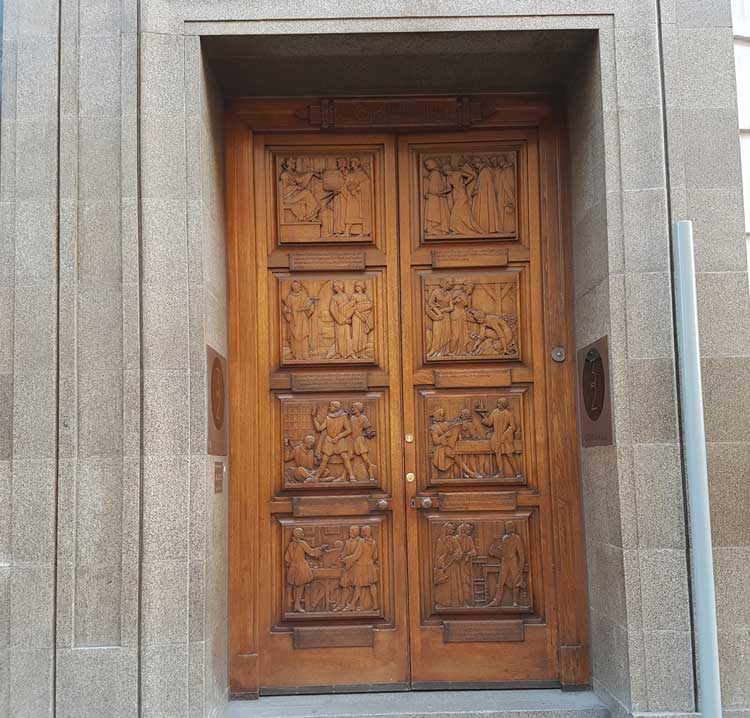
I wonder how many people as they undertake their daily routine of traipsing up and down Cornhill, or vice versa, ever notice the exquisitely carved wooden doors of number 32 Cornhill?
I have to confess, despite doing regular walks in their general vicinity, and probably passing them on numerous occasions - I was amongst the many people who remained ignorant of their existence.
But then, one day, I happened to be passing them on a Sunday morning and I was suddenly struck by one of those Eureka! moments that London has the wonderful habit of delivering to you when you least expect it to happen.
Now, whenever I pass them on a tour, I make sure to draw my group's attention to them - and, whenever I point them out to those who work in the vicinity, the response is often a resounding, "do you know, I've never noticed those doors."
And, let's be honest, it is an understandable response - after all, when did you last bother to take the time to look closely at all the doors you walk past as you go about your daily routine?
First off, permit me to explain exactly who Walter Gilbert was.
Walter Gilbert (1871-1946) was a designer and modeller, who worked mainly in metal. He cut his sculpting teeth, so to speak, with the Arts and Crafts Movement towards the end of the 19th century, and then went on to embrace architectural sculpture in the first half of the 20th century.
Although you might not instantly recognise his name, there is a good chance you have admired one of his most prominent creations, as it was he who was responsible for the gates of Buckingham Palace. He was also responsible for the sculptures that adorn the façade of Selfridge's on Oxford Street.
The mahogany doors that adorn the entrance to number 32 Cornhill, formerly the headquarters of the Cornhill Insurance Group, were, in fact, designed by the Birmingham artist and illustrator Bernard Philip Arnold (1893 - 1985) and were then carved by Walter Gilbert.
The doors comprise eight panels which each feature a specific period, or even moment, from the history of Cornhill.
So, jump aboard the Walter Gilbert time machine and let us set off on a journey through the history of this historic and ancient thoroughfare.
Each carved panel is followed by a heavy-type inscription that gives a brief description of the scene depicted in the panel, above it.
The panel reads:-
"St Peter's Cornhill founded by King Lucius 179 A. D. to be an Archbishop's see and chief church of his kingdom and so it endured the space of 400 years until the coming of Augustine the monk of Canterbury."
The carved panel shows a priest standing before King Lucius, who is seated on his throne. The priest holds up the plans for the church, which the king is inspecting. Next to the priest stands a builder holding a compass and a plane.
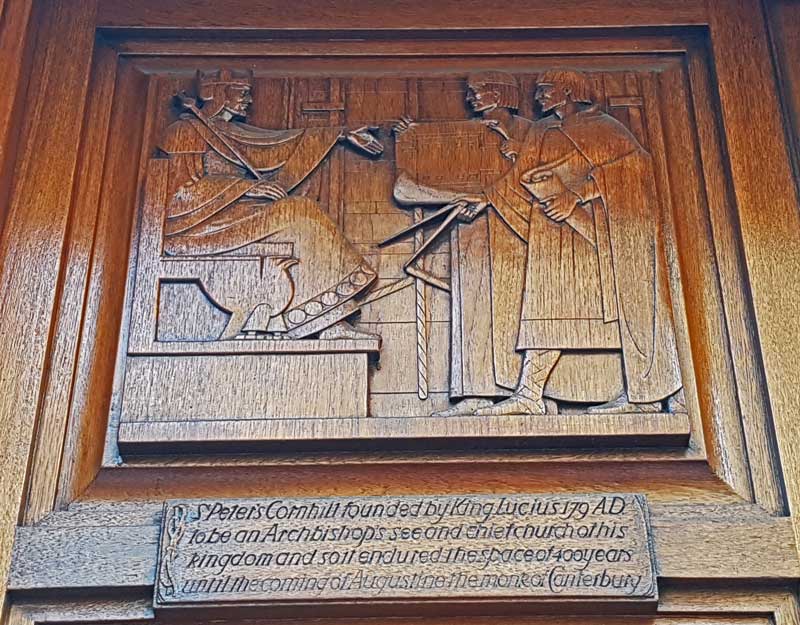
The panel reads:-
"Eleanor, Duchess of Gloucester, did penance walking barefoot to St Michael's Church from Queen Hithe, 1441"
The panel shows Eleanor, looking very dejected, holding a taper. A hooded priest walks in front of her, and a group of clerics follow behind.
Eleanor (1400 - 1452) was the mistress, and then the wife, of Humphrey, Duke of Gloucester.
In 1441 she was convicted of sorcery, having asked the astrologers Thomas Southwell and Roger Bolingbroke to cast the horoscope of the then King Henry VI.
Found guilty, she was ordered to perform public penance, which is the subject of the panel. In addition she had to divorce her husband; and was also sentenced to life imprisonment.
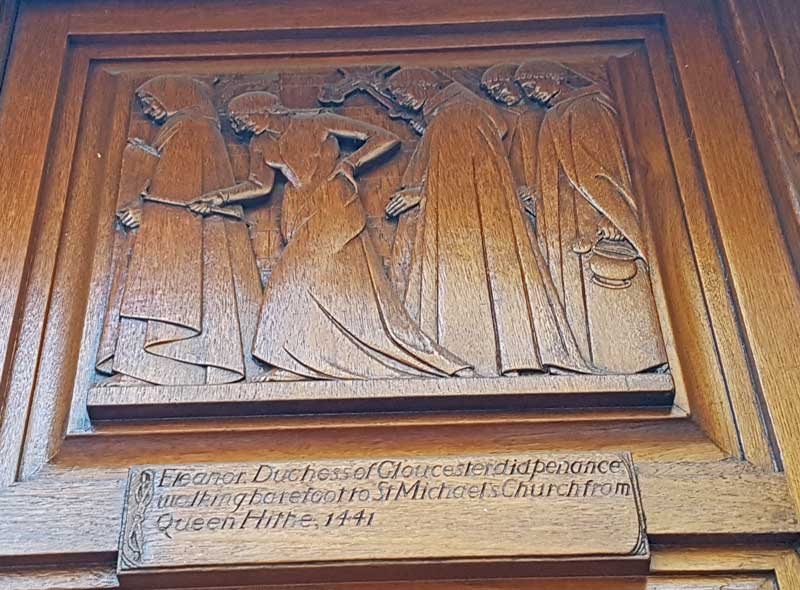
The panel reads:-
"Cornhill was anciently a soke of the Bishop of London who had the Seigneurial oven in which all tenants were obliged to bake their bread and pay furnage or baking dues."
The panel shows two women in medieval attire walking away from the oven holding their freshly baked loaves. A priest records the payment of two bags of money, which can be seen on the step beside his foot, in a ledger.
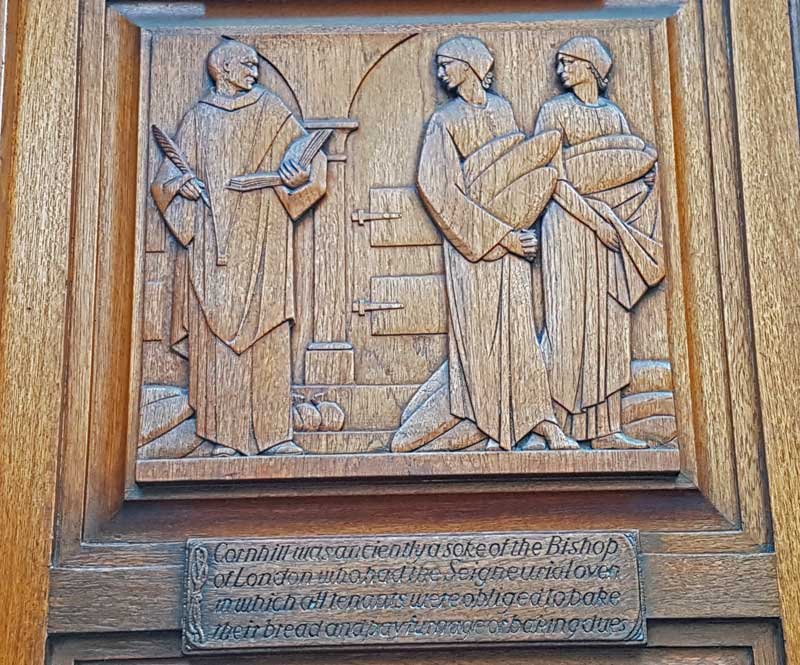
The panel reads:-
"Cornhill is the only market allowed to be held after noon in the 14th century."
The panel shows a 14th century stallholder at the Cornhill market selling apples to two ladies dressed in medieval costume.
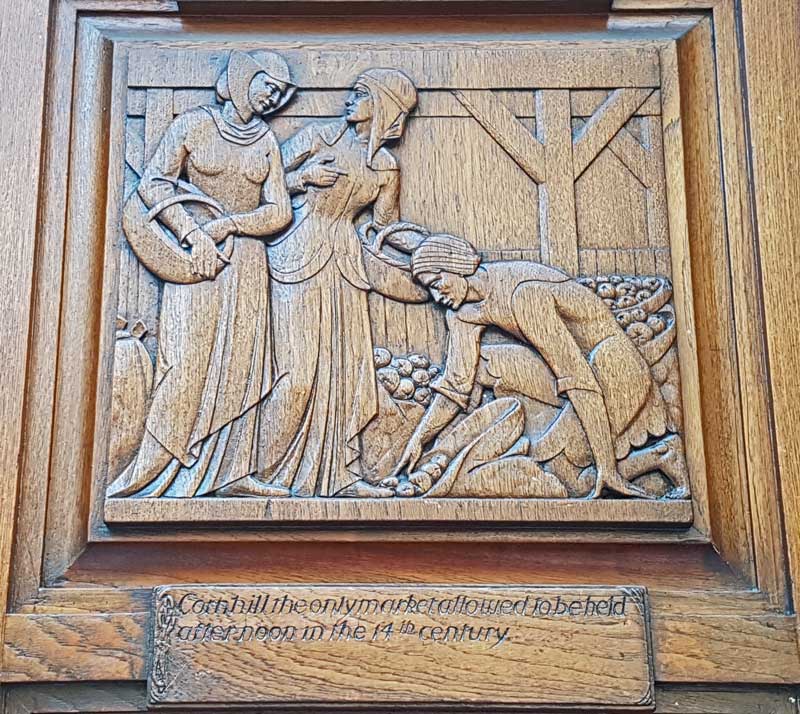
The panel reads:-
"Birchin Lane, Cornhill, place of considerable trade for men's apparel, 1604."
On the panel, a tailor sits a crossed-legged tailor who is adjusting the hem of a gentleman who is admiring himself in a mirror that he holds up to his face. The tailor's assistant stands behind the gentleman holding a tape with which he is measuring their client.
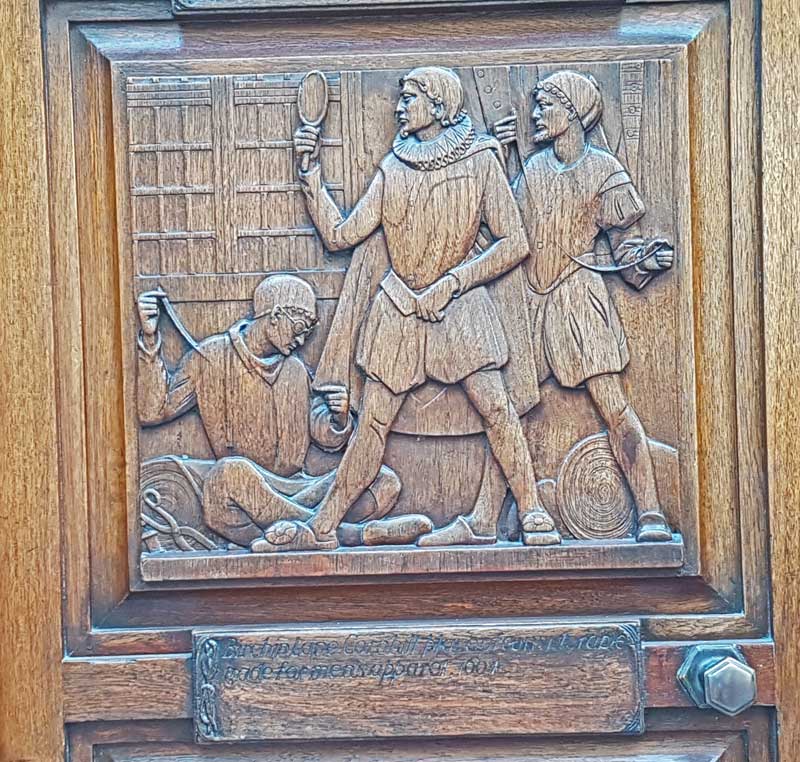
The panel reads:-
"Pope's Head Tavern in existence in 1750 belonged to Merchant Taylor's Company. The Vintners were prominent in the life of Cornhill Ward"
The panel shows a waiter at the nearby Pope's Head Tavern (for which nearby Pope's Head Alley is named) serving wine to two gentlemen who are seated at a table.
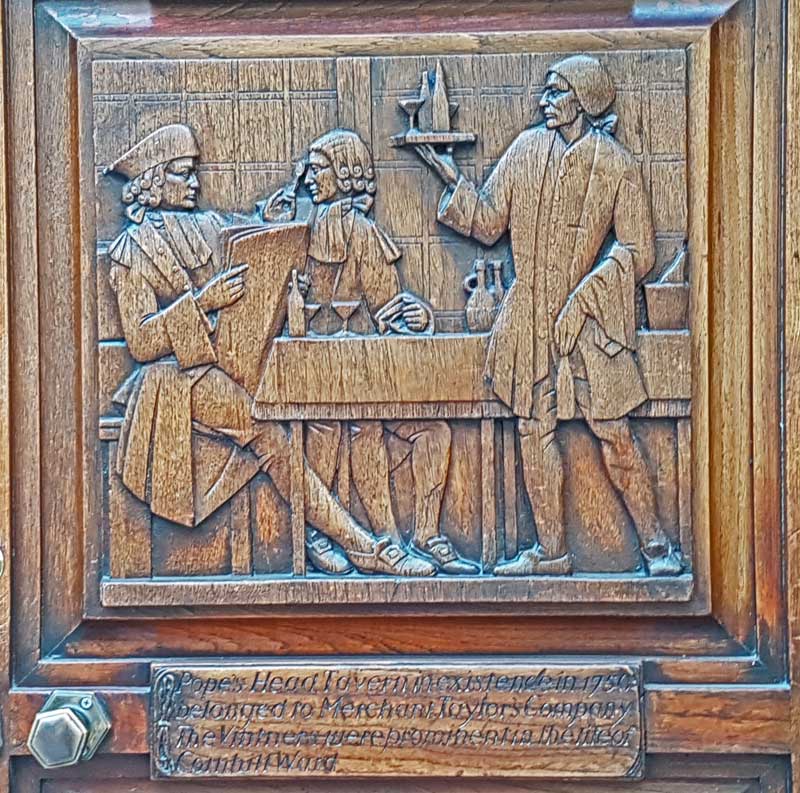
The panel reads:-
"Garraway's Coffee House, a place of great commercial transaction and frequented by people of quality."
The panel shows a group of 18th century stockbrokers (people of quality!) gathered in Garraway's Coffee Shop, which used to be around the corner in Change Alley.
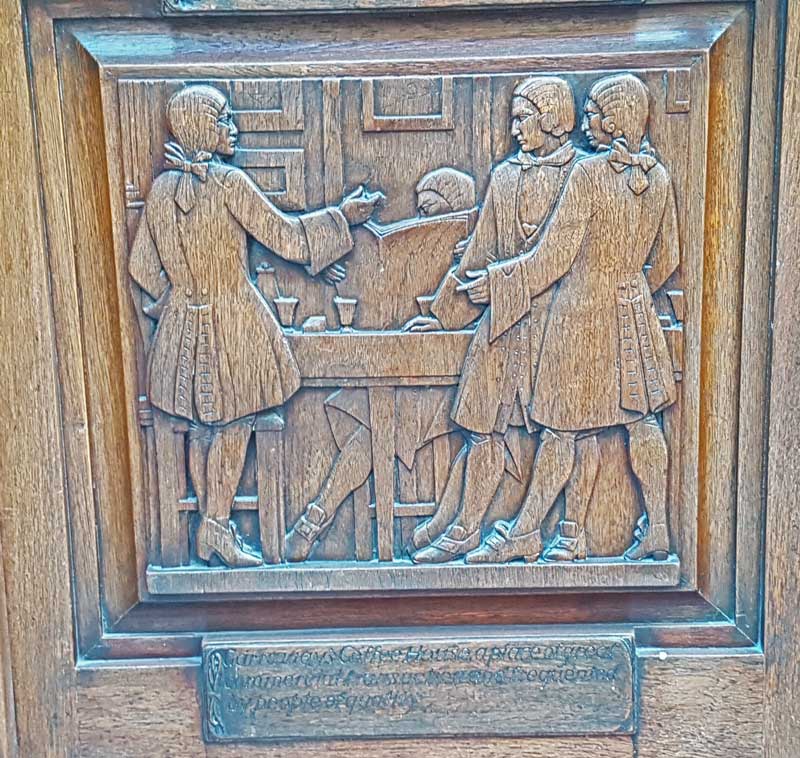
The panel reads:-
"Thackeray and the Brontes at the publishing house of Smith Elder & Co. Cowper, the poet, Gray the poet, Guy, the bookseller and founder of Guy's Hospital, lived in Cornhill."
The panel depicts Charlotte and Anne Bronte meeting with William Makepeace Thackeray at the premises of Smith Elder.
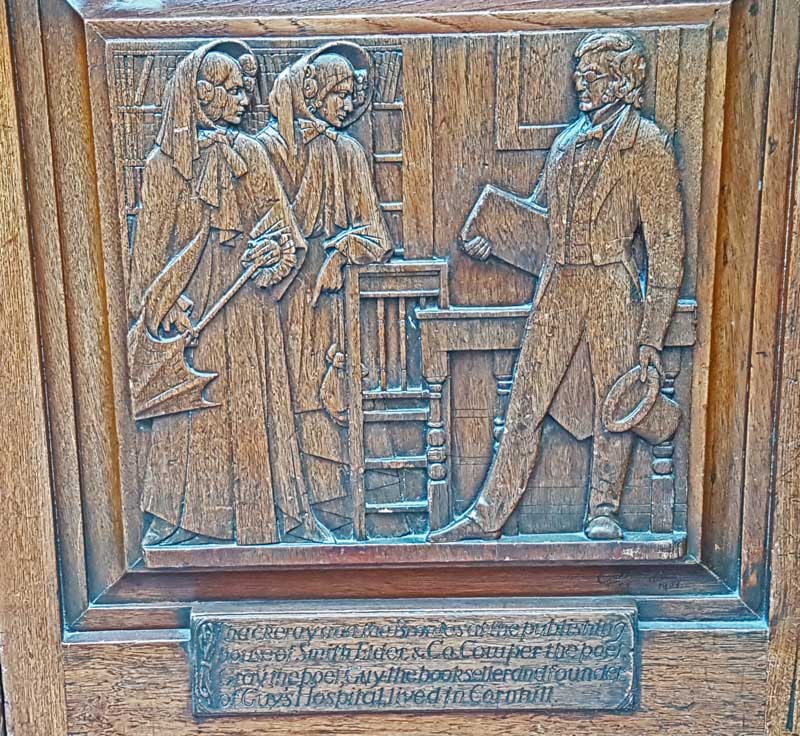
And so our wander through the various events in the history of Cornhill through the ages draws to its conclusion.
You can study the panels on this page as much as you want, but there is no substitute for making your way to Cornhill, standing outside number 32, and admiring the doors up close and personal as you enjoy the puzzled glances of passers-by who hurry past wondering what could be so interesting about a pair of doors.
But, as you now know, doors can be exceedingly interesting - in fact, they can, and in this case do, tell a fascinating story.